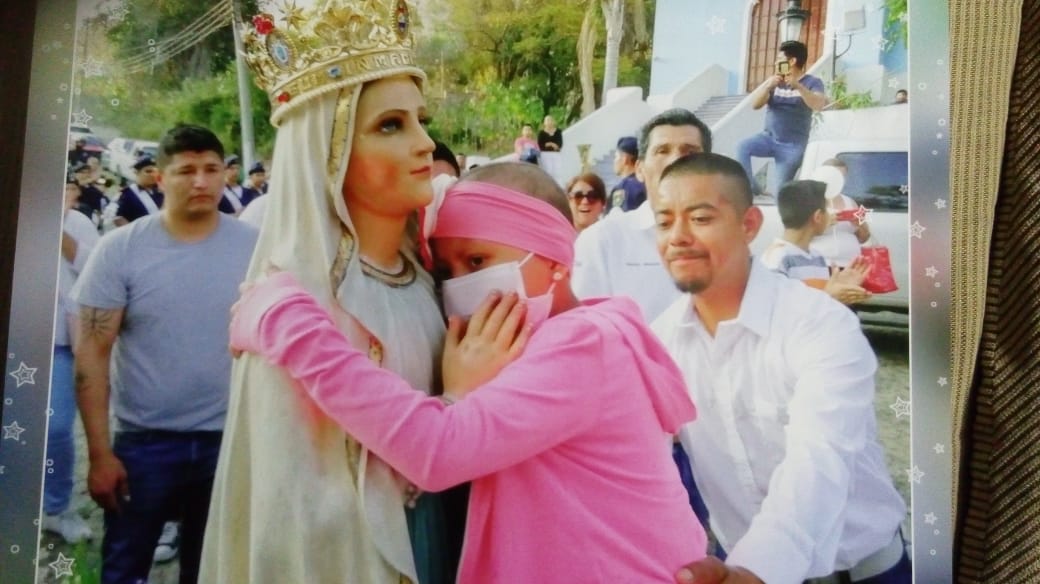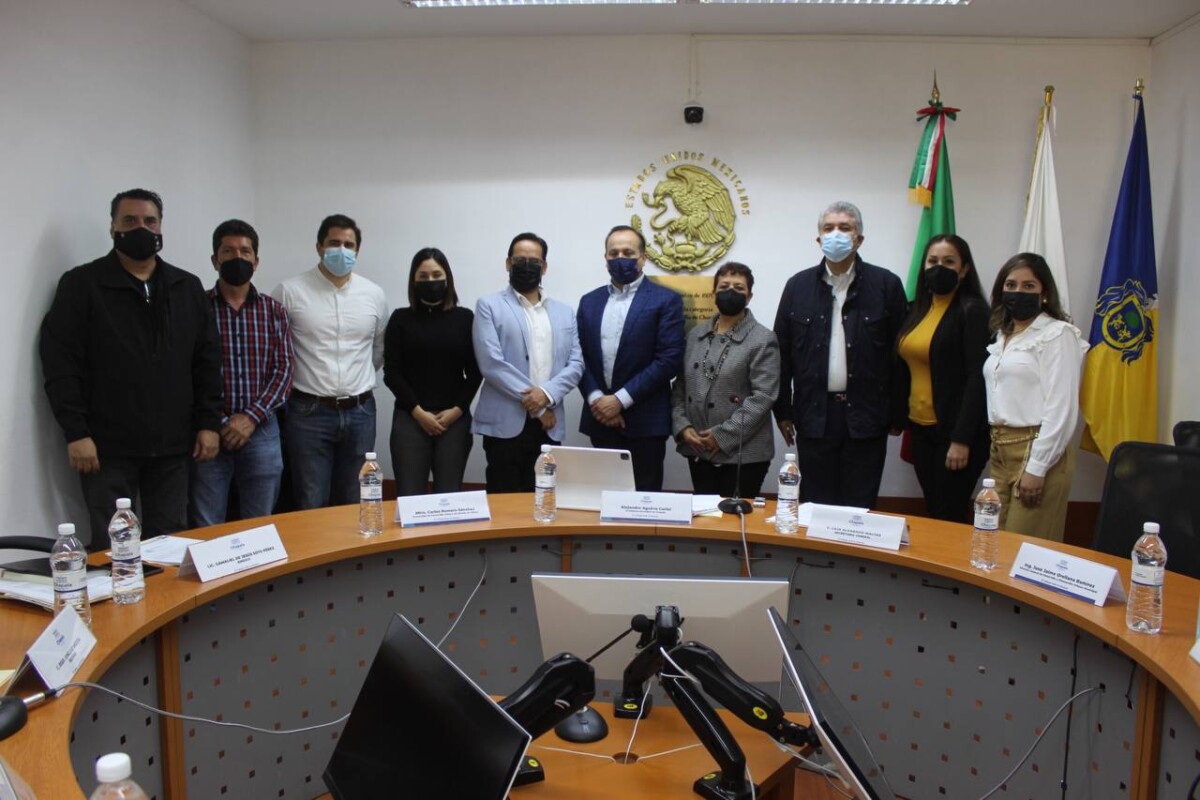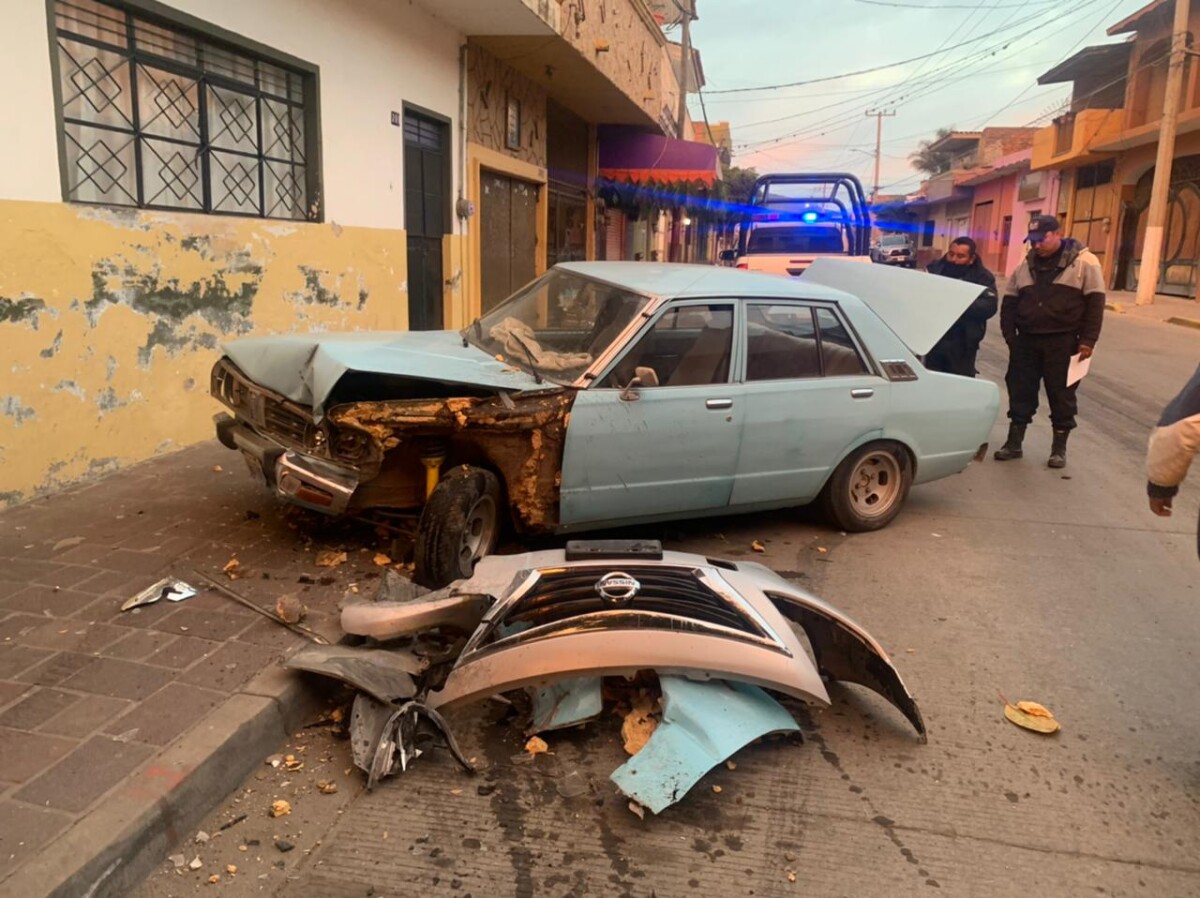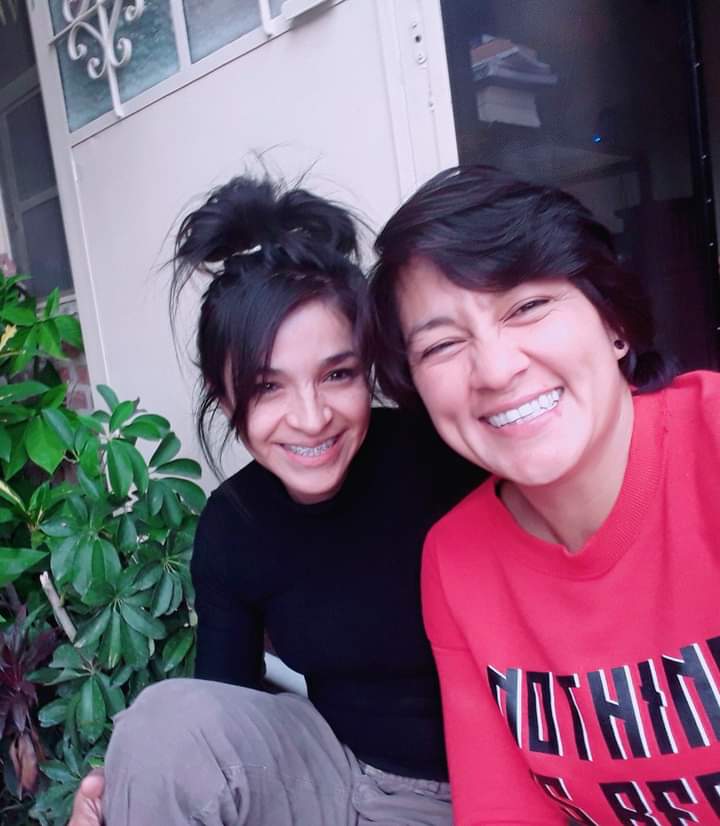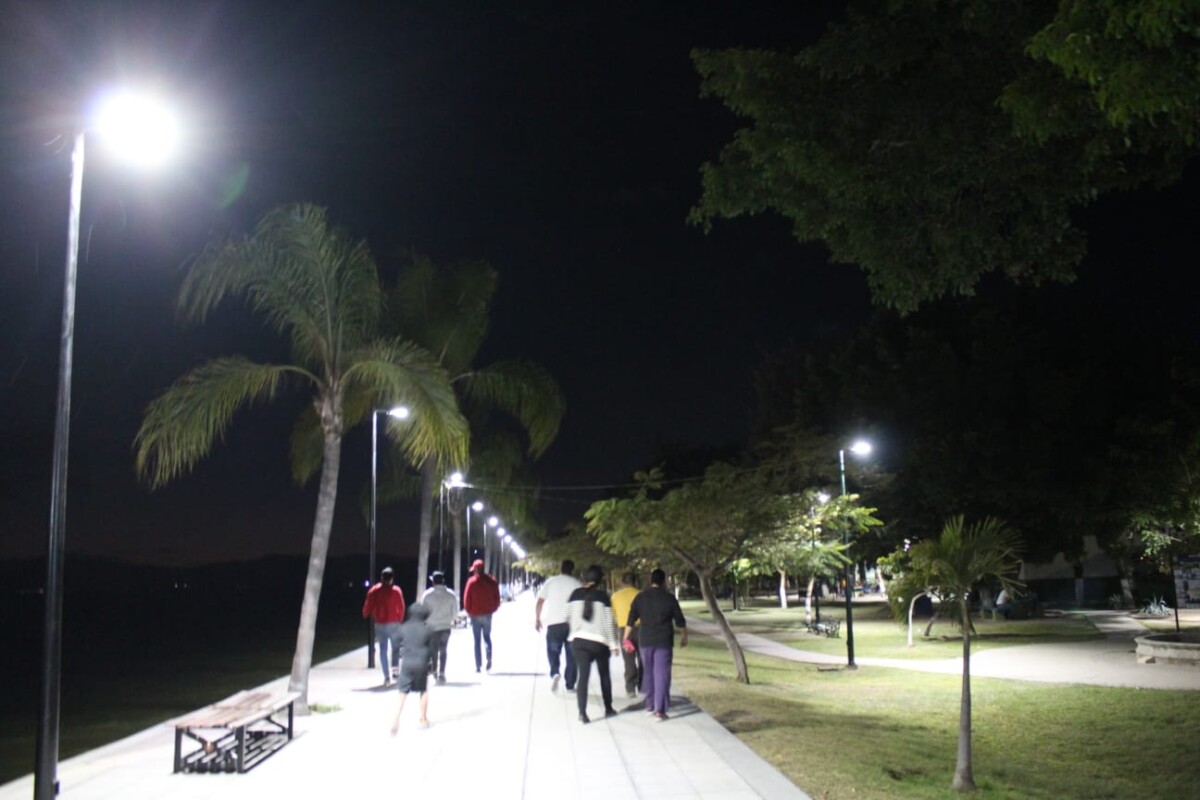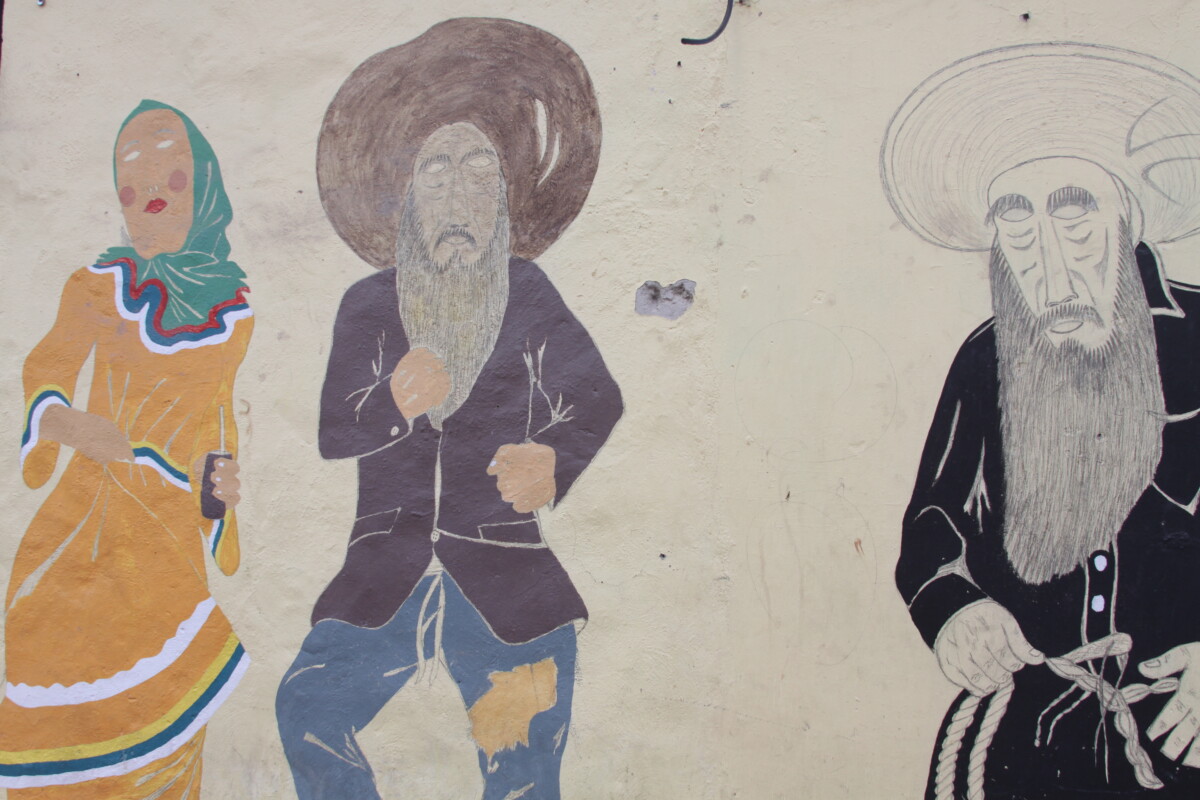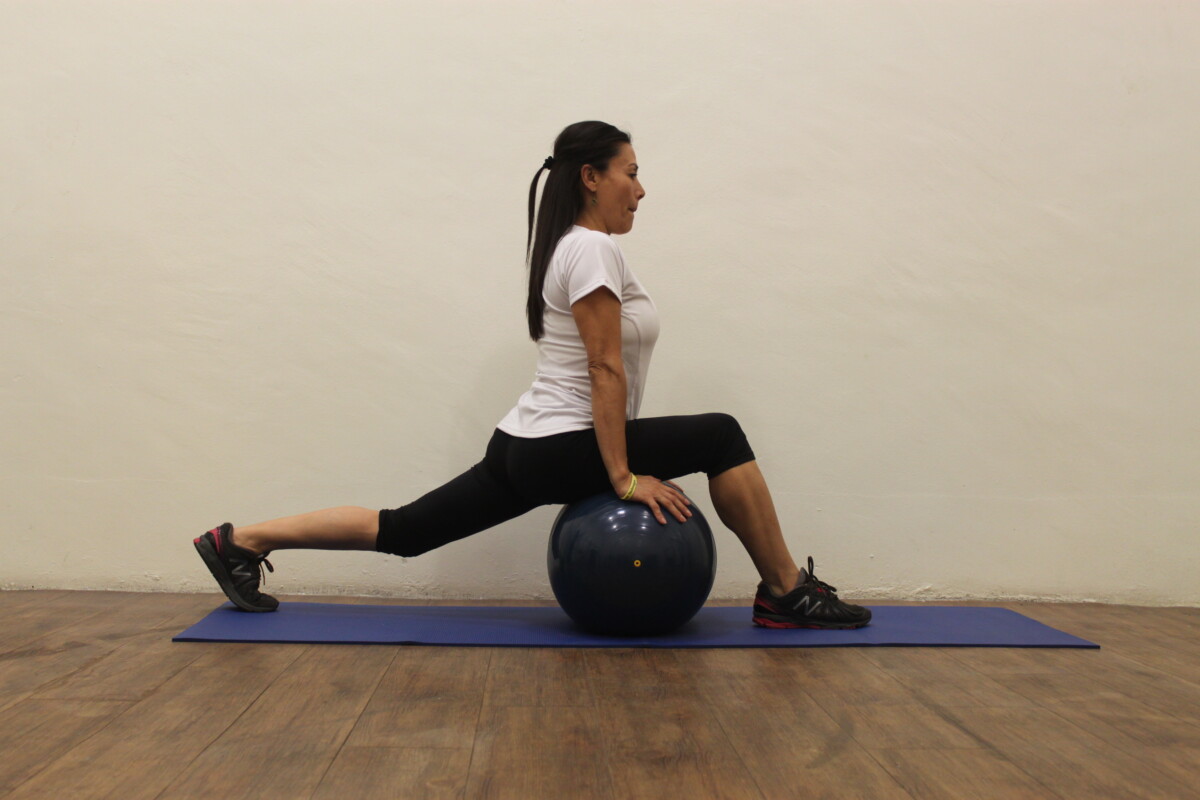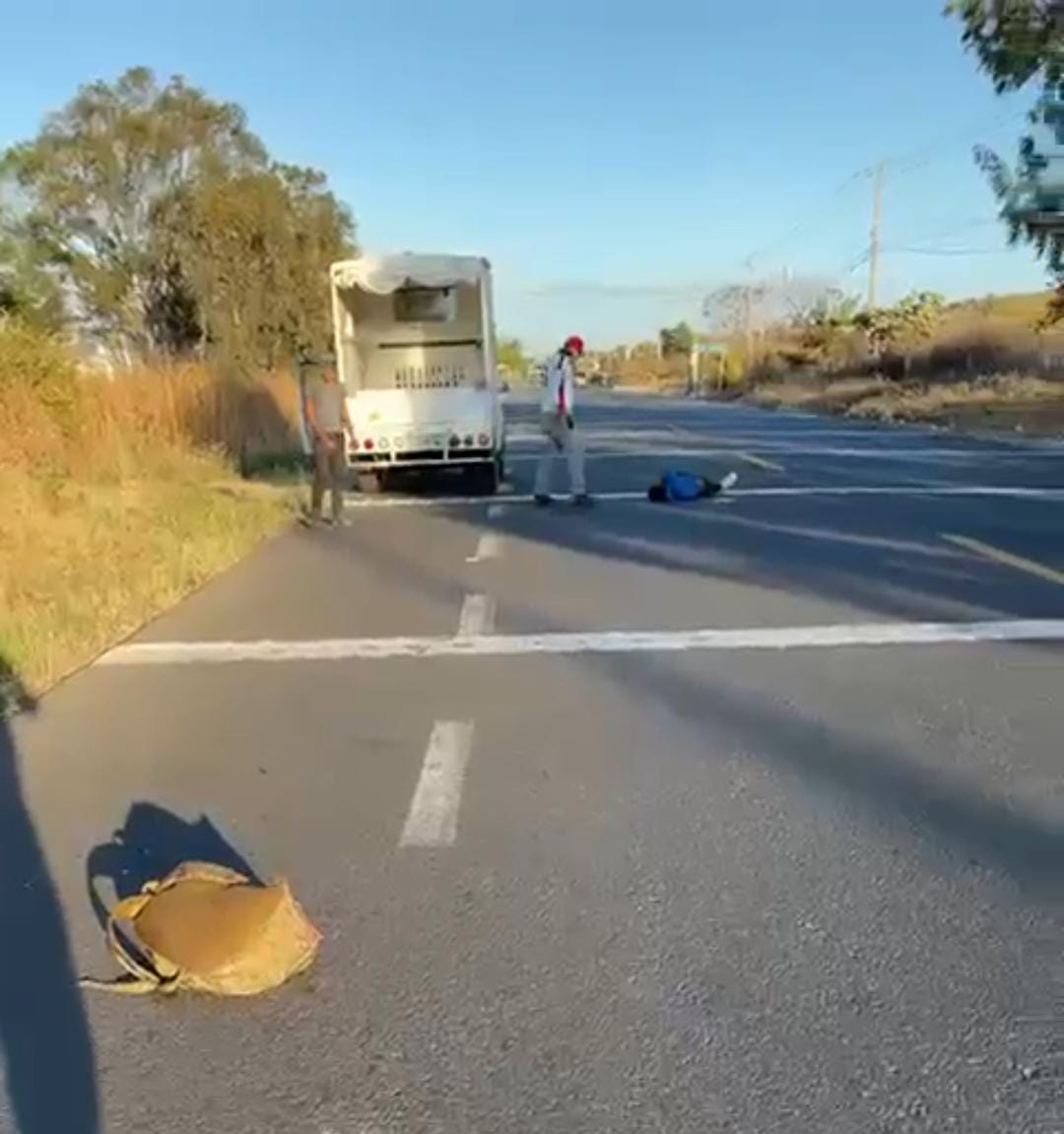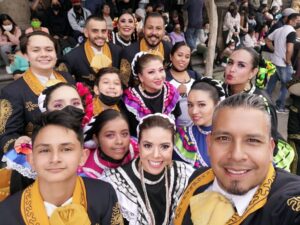en inglés
Nina, the ‘miracle child’ embraced by Our Lady of Lourdes
Nina the first time she embraced Our Lady of Lourdes in front of her chapel. Photo: Daniel Padilla.
Jazmín Stengel (Chapala).- Twelve year-old Nina Yocelin Martínez Flores, daughter of Mara de Lourdes Flores López and Diego Ernesto Martínez Jiménez is considered the miracle of the year in the Lourdes neighborhood Chapala.
The teenager was diagnosed with leukemia in 2019. «It was a very serious situation, we did not know what to do about it,» said Diego, the girl’s father. Being a very religious family, the parents began Nina’s treatments, but trusted their faith.
In spite of the desperation and how complicated it is to help a family member lying in a hospital bed, the Martínez Flores family received a lot of help. “Every time I arrived with my mother, the neighbors or relatives had left something to support us,» said Diego.
After a year of treatment, Nina was able to return home. Her father Diego, an active participant in the vigil of St. Francis of Assisi, asked permission to receive the statue of Our Lady of Lourdes and lay his daughter at the feet of the Virgin. Incredibly for all present «the Virgin embraced Nina,» commented neighbors after seeing Daniel Padilla’s photograph.
Nina says that on that day the Virgin, in her invocation of Our Lady of Lourdes, spoke to her as she went up and embraced her. She heard a clear voice that said «you are going to be cured, daughter, you are going to be cured». Although the parents were skeptical at first, the confidence that their daughter showed, made them believe.
It was not the only time something similar happened, in the last three years Nina’s parents have taken her to view the Virgin of Lourdes and St. Francis of Assisi. On more than one occasion the now teenager had unexplainable experiences, in which she claims to have heard voices or felt observed by the images in the temples.
After three years of continuous treatment, Nina Yocelin Martinez is stable. This miracle strengthens the faith of the neighbors of the Lourdes neighborhood. Although leukemia is a disease with regular relapses, the girl has not had any so far.
Translated by Christalle Dalsted
Municipal Commission for Regularization of Urban Properties (COMUR) of Chapala installed
COMUR members and Chapala authorities in the council chamber.
Laguna Staff.- The mayor of Chapala, Alejandro de Jesús Aguirre Curiel, swore in the members of the Municipal Commission for the Regularization of Urban Properties (COMUR). The objective of the commission is to give legal certainty to the citizens and the City Hall itself about their documentation and deeds that give them the ability to transfer, sell or dispose of their properties.
Aguirre Curiel, who presides over the commission, swore in its eight members and proposed the director of Urban Development and Planning, Jaime Arellano Rodriguez, to be the technical secretary of said municipal body.
During the installation of the COMUR on February 15, Jalisco’s Urban Development Attorney, Carlos Romero Sanchez, was present and recognized the importance of the commission’s work in updating the properties.
He also spoke of working in a coordinated manner to demand that state deputies update legal instruments such as the State Zoning Regulation, which dates back to the mid-1990s, the Urban Code in force since 2009, and the General Law of Human Settlements of 2016.

The mayor of Chapala, Alejandro Aguirre Curiel, with the Jalisco Urban Development Attorney, Carlos Romero Sánchez.
The people who make up the commission are the following council members: Jesús González Amezcua, of Acción Nacional (PAN); Mayra Raquel Morales Cerda, of Movimiento Ciudadano (MC); Irma Paulina Vázquez Baltazar, of Revolucionario Institucional (PRI); María Isabel Mendoza Rodríguez of Hagamos. In addition, the trustee, Gamaliel de Jesús Soto Pérez, the general secretary, Lilia Alvarado Macías and José Barajas Gómez, director of Cadastre.
Arellano Rodríguez, as technical secretary of the recently formed COMUR, reminded everyone that the regularization of properties was a campaign proposal of the current mayor. He proposed to work jointly with the City Hall agencies so that many elderly people can inherit properties who have not been able to do so due to that due to irregularities in their property titles and documents.
Translated by Sydney Metrick
Motorist crashes into parked car in Jocotepec and then flees
The powerful impact caused severe dents in the hood of the parked car; while the driver lost the fender.
A Nissan Versa collided with a parked car in Jocotepec. The accident occurred during the early morning hours of February 13.
The loud bang woke up the neighbors on Morelos Street, between López Rayón and Niños Héroes Streets, at 6:15 am when a driver crashed head-on into a parked car.
After the impact, the parked car had dents in the hood and was pushed to the sidewalk, while the driver lost the fender of his car. The driver of the silver Nissan Versa fled the scene.
The car was apparently traveling from east to west, according to witnesses, while speeding and zigzagging across the small square of La Campana. The driver lost control and ended up hitting a parked vehicle.
The owners of the parked car followed the trail of the liquid that spilled from the fleeing damaged car, which was finally located in a vacant lot on Independencia Norte Street, at the foot of the hill. However, the driver had already fled the scene.
After notifying the Municipal Police, the car that caused the accident was found. No injuries were reported.
Translated by Colleen Beery
Mimi and Judo: a genuinely unconditional love
Mimi Martínez and Judo Zamora, both from Ajijic, have been in a relationship for just over four years.
Sofía Medeles (Ajijic).- This is the story of Noemi Milagros Martinez Romero – «Mimi» and Judith Reyes Zamora – «Judo,» two women who, despite the ups and downs of their relationship, have fought against rejection, discrimination and criticism to move forward together.
Although they were neighbors in their youth, they actually met just under five years ago when Judo moved into an apartment near Mimi’s current residence. In a short time, they went from sharing greetings to having coffee; after four months of living together, their friendship turned into love.
«I liked Judo and flirted with her, but since I have my family, she didn’t think I liked her. Love stirred during those four months of living together, visits and so on,» said Mimi.
The beginning of their romance was difficult mainly because of their families, but also due to the discriminatory comments of the people around them. «Family opinions played an important role. When my family found out, many turned away and didn’t accept it. It took time for them to agree with what I wanted,» Mimi said.
Judo added that her close ones also put a «but» in front of the relationship due to the fact that Mimi already had children, but the couple overcame the criticism. «Eventually, we decided that other people were not going to make us happy. The relationship is about us, no matter what other people think.»
Mimi stated that her priority was her children, who accepted their relationship in the best way, showing that the only thing that mattered to them was their mom’s happiness.
«It’s an easy relationship, but it’s hard in this case because I have a family. Judo not only deals with my personality, but also with the personalities and dynamic of the five of us. Judo has been very supportive, because she has always had a good friendship with my children. She has represented the figure that is missing in the family, and she is both their confidante and their support.»
In the middle of the pandemic they got engaged, but they wanted to be sure before getting married that they had taken steps to build a strong foundation for their future life.
«For us, marriage is a symbol that our relationship is afloat despite everything we have been through, as well as being a document that formalizes the relationship. It is important because it represents the union we have,» added Mimi.
They also reaffirmed their support for each other’s work. Judo, who owns Lucky Bar, said that Mimi had helped her decorate and often assists her in events. For her part, Mimi has her craft and gift business called Nahomi’s Mimi Craftmiss, for which Judo has always shown her unconditional support.
Finally, they had advice for those who wish to be happy: «If you start thinking about all the criticism, you will never move forward. But when you know what you want, you have no choice but to fight against the world for a time and then you will be at peace with your choice.»
Although the beginning of their romance was difficult because of «what people will say,» now they live their love in freedom and are already engaged.
«We are already in the 21st century. After the pandemic, we learned that there is no time to lose; we have to look for and fight for what makes us happy, no matter what people say. We must seek happiness and emotional balance, anything else is extra,» concluded Judo.
Marriage equality has been legal in Jalisco since 2016. More recently, the state no longer requires couples to file a protective lawsuit, and they can get married in any civil registry of the state.
Translated by Rebecca Zittle
Light bulbs replaced on on Ajijic malecon
70 new lamps light up Ajijic’s malecon. Photo: Sofía Medeles.
Sofía Medeles: Personnel from the Ajijic delegation replaced the bulbs of 70 streetlamps To improve illumination on the malecon.
The installation work, as well as the pruning of some trees, was carried out on Wednesday, February 16. The new bulbs are distributed between the walkway and La Amistad Park.
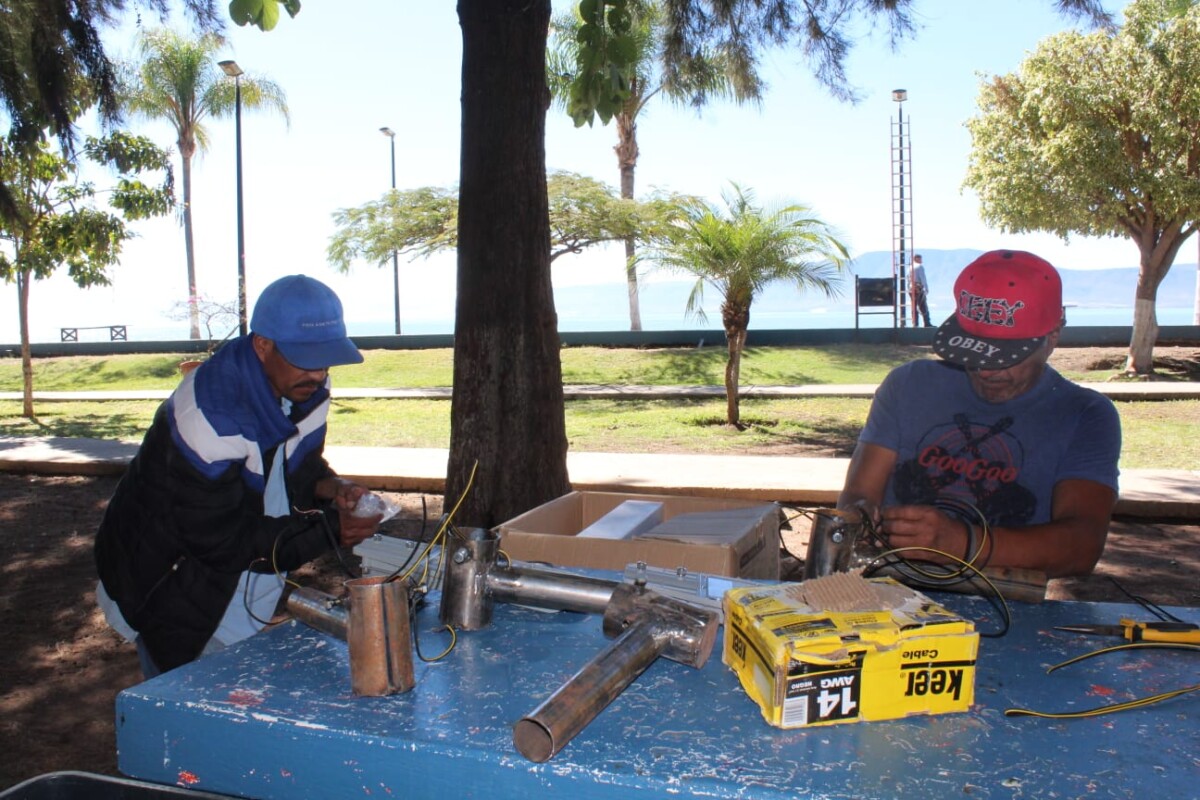
Delegation personnel carried out the installation last February 16 on the malecon. Photo: Sofía Medeles.
Maximiliano Macías Arceo, the acting delegate of Ajijic, stated that bulbs that were removed but still work will be placed in areas with lighting problems, such as Lázaro Cárdenas Street or La Canacinta neighborhood.
Translated by Sandy Britton
Lakeside Chronicles: The sayaco is the inner child
Front wall of the Romero Pérez brothers’ home is illustrated by masked Sayacos, created by Aarón, one of the brothers. Photo by: María del Refugio Reynozo Medina
María del Refugio Reynozo Medina (Ajijic).- José de Jesús Romero Pérez still has the first hermit-like sayaco mask he made 15 years ago. The dark brown, immobile, sharp face is made of copal, a wood that he brought from the hills. The hollows of the eyes and the slightly open mouth are decayed. The eyebrows, beard and straw-colored mustache are made of a fiber obtained from coffee sacks.
Making a mask can take José de Jesús about two and a half weeks, working in the afternoons after his usual workday. Although he does not make them for commercial purposes, the unique masks which bear his signature, can sell for up to three thousand pesos. The masks that depict women (sayacas) are colorful, with embossed or painted eyelashes and eyelids splashed with glitter. Once carved with a chisel, vinyl paint is used to outline the eyebrows, eyes and eyelashes. The lips and cheekbones are painted deep red circles.
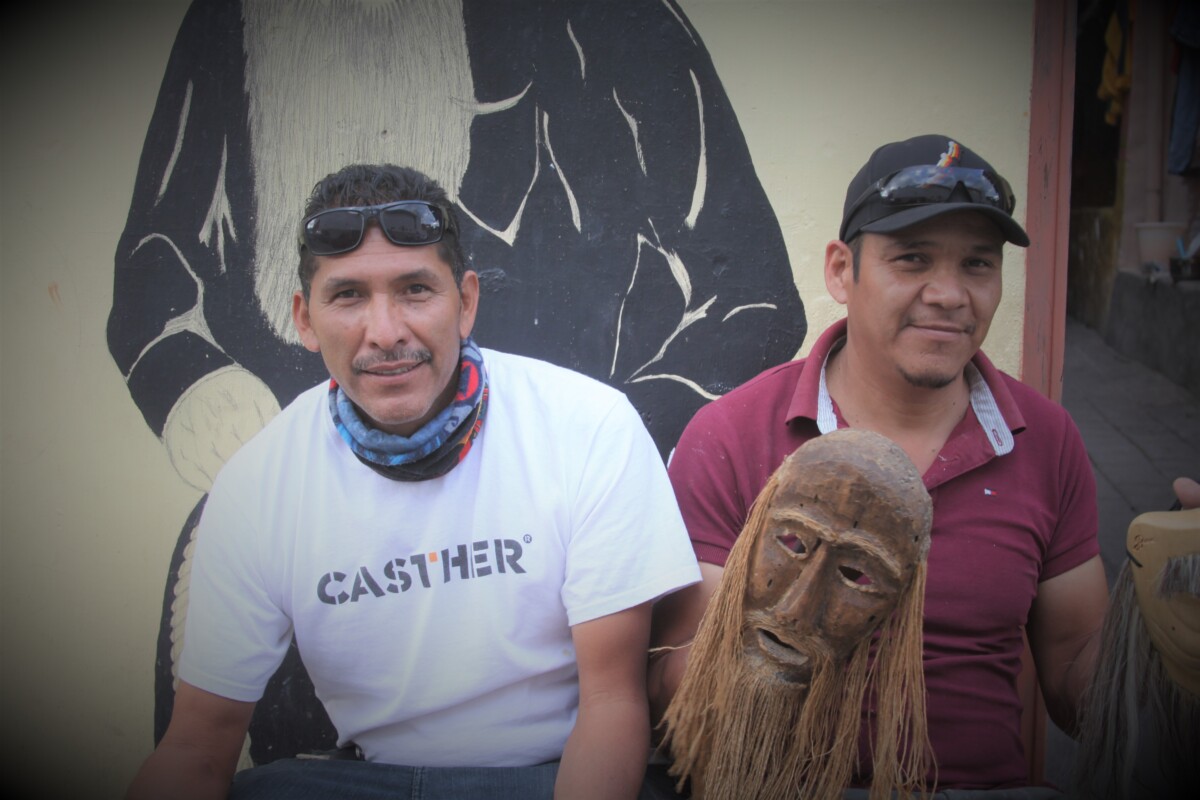
Abel and José de Jesús Romero Pérez grew up watching the sayacos and chasing them in many celebrations. Photo by: María del Refugio Reynozo Medina
The male masks of the sayacos are made of natural light or brown wood, with long beards, bushy eyebrows and moustaches made of horsehair. Romero Pérez’s masks are instantly recognizable. The images flow, as he chisels each feature. A face will emerge unexpectedly from the wood. He knows perfectly well the type of wood needed to design each face. In addition to wood from the native copal tree, he uses native tecomaca wood, which is soft and light.
He has sold eight masks. Buyers do not necessarily wear them in parades. They are purchased by collectors as unique pieces, inspired by the sayacos.
The Romero Pérez brothers Abel, José de Jesús, Gaspar, José, Aarón and Modesto, each year transform themselves into sayacos mainly to inaugurate the carnival. They also attend other celebrations throughout the year.
On a wall outside their home there is an unfinished mural painting drawn by Aarón. The image shows a dancing female sayaca dancing wearing a yellow dress trimmed with colored ribbon and brown booties, accompanied by two male sayacos. One is dancing wearing a brown jacket, denim pants and booties. The other sayaco has a black dress with white dowels as buttons. All of them have long faces, although their appearance in the parades brings smiles and laughter.
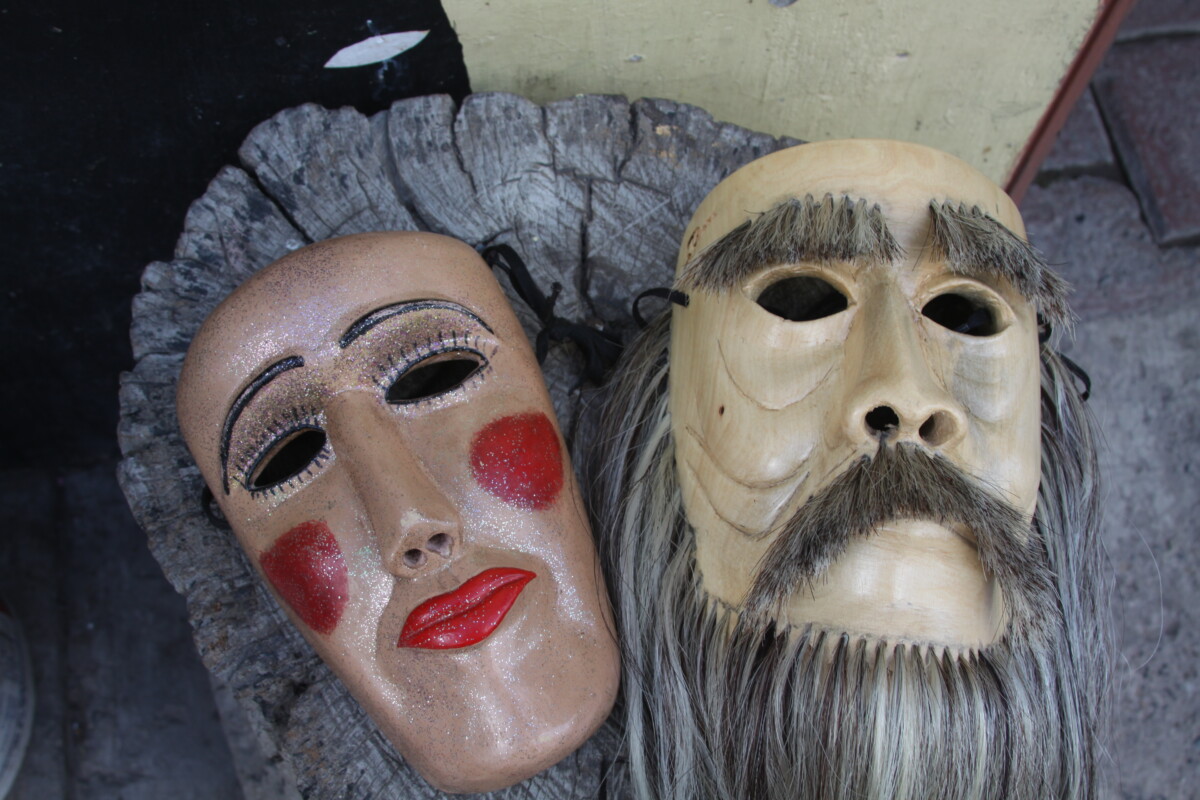
With copal or tecomaca wood, the masks made by Jesús Romero are unique pieces. Photo by: María del Refugio Reynozo Medina
“The sayaco is a very old character in the life of the people of Ajijic”, says Abel. They used to be called sayacal. Now they are called sayacas and sayacos. It is that mocking character that appears mainly in the carnival. They throw confetti and sometimes flour. Sometimes the flour is delicately smeared on their cheeks.
One of the main dances of the sayacos is called the dance of the «papaqui» which is accompanied by wind instruments. Sometimes they are invited to perform their dances at weddings or quinceañeras, the celebration of a girl’s 15th birthday. Abel remembers as a child watching the sayacos in the daily festivities. He and his siblings would race through the cobblestone streets following and teasing the sayacos amidst happy laughter.
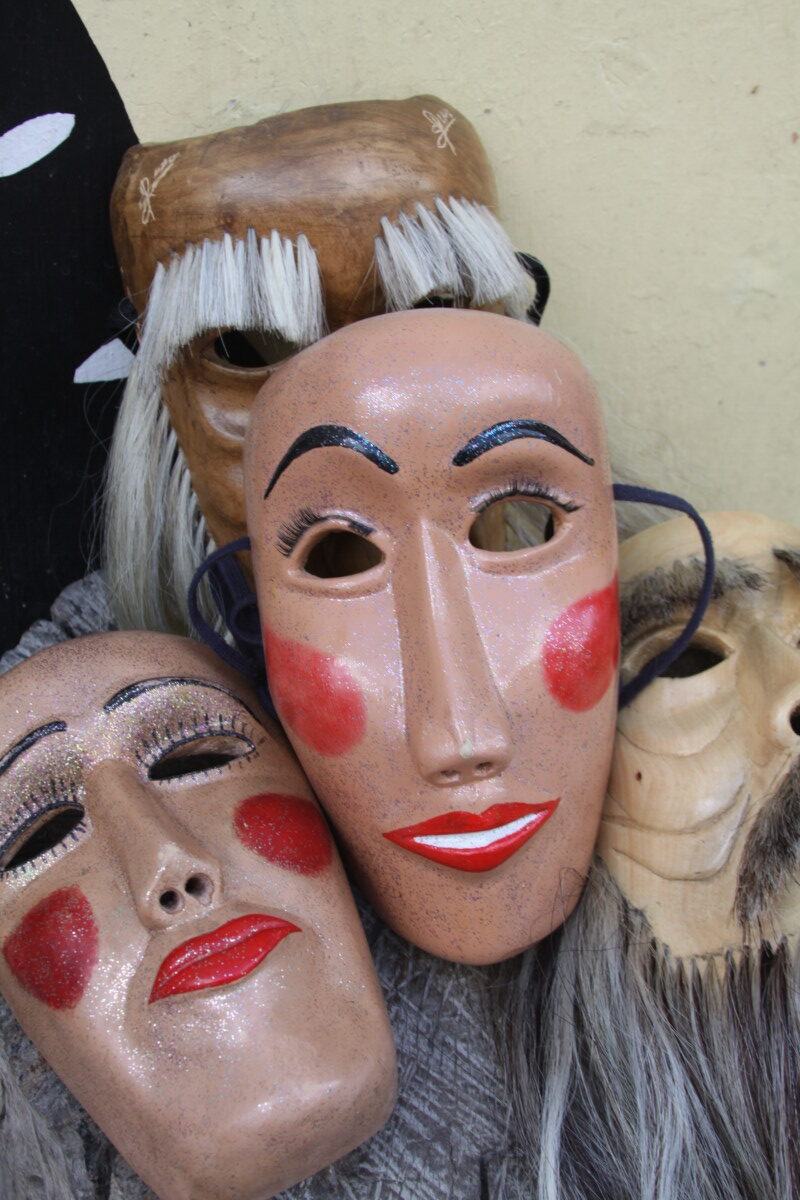
The masks of Jesus Romero Perez stamped with his signature can be worth up to three thousand pesos. Photo by: María del Refugio Reynozo Medina
The carnival parade is open to the entire population and a diversity of characters appear. The traditional attire is wooden or papier-mâché masks, sacks, shirts with dowels, booties, and hats. The sayacas wear bright printed dresses.
There is pride in being a sayaco. It is a nice, mocking, very old character who makes people laugh. The sayacos are mainly men. Even the sayacas are usually men because of the pushing, shoving, brawling atmosphere.
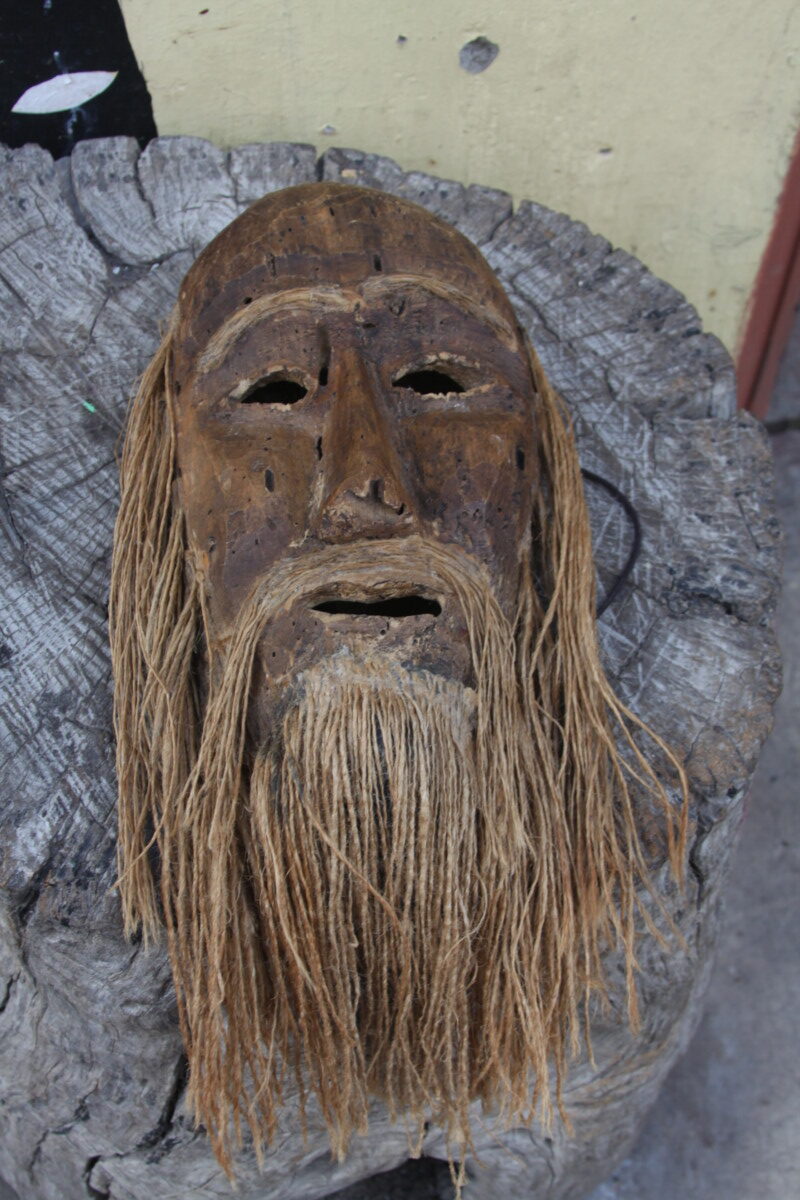
The first mask made by José de Jesús Romero Pérez was of a hermit in copal wood. photo by: María del Refugio Reynozo Medina
Behind the masks of tough men or picturesque red-cheeked women are the Romero Perez brothers. They appear in the parades and processions so that the legendary figures of the sayacos do not die and because Abel says «behind the wooden masks is the inner child.»
Translated by Nita Rudy
Health & Wellness:
By Leticia Trejo
The beliefs that dwell deep in our minds are the hardest to eradicate. For many years I firmly believed that 30 minutes of physical activity a day was what everyone needed to be fit and improve their health. That is, until I read an interesting piece of research that convincingly proved the 30 minutes a day claim was a myth.
Researchers chose 300 people from a company with a working schedule from 9 a.m. to 5 p.m., and 150 of them (office administrative workers) were asked to do 30 minutes of exercise a day. They could choose between going to the gym, getting on a treadmill or going for a walk outdoors. The other 150 – workers from the cleaning and maintenance service of offices throughout the building – were asked to continue their daily activities. Evaluation was through a blood test at the beginning of the study that measured levels of triglycerides, cholesterol and sugar. This evaluation was repeated after six months. The surprise for everyone was that the cleaning and maintenance workers had better test results than those who integrated 30 minutes of exercise into their daily routine.
This is not to say that exercise doesn’t work, but that sedentary lifestyles can kill us. Some scientists even say that sitting at a desk for eight hours is equivalent to smoking a pack of cigarettes a day.
Ian Jansen, Ph.D., is a professor in the Department of Public Health Sciences of the School of Kinesiology and Health Studies at the Physical Activity and Obesity Research Institute in Canada. In addition to this study, he has conducted many more on the influence of sedentary behavior on health.
This reminds me of the time I heard – during an international congress – the perfect formula for maintaining physical health. A very important lecturer gave a talk full of knowledge and wisdom about stress, exercise and life habits. In the question and answer segment someone asked him, «Professor, what is the ideal formula to be in shape?» He answered, «Go for a walk with your dog three times a day, after every meal… whether you have a dog or not.» The auditorium was full of laughter, but he was right. Our lives should be physically more active. For example: use the car less; walk more to stores, banks and malls; do the house cleaning yourself; and walk 20 minutes after every meal.
A doctor who was my friend and student in yoga classes told me another way. He said when a patient asked him how often they had to exercise he would answer, just every time you eat.
This applies perfectly to people who are not physically active, because Dr. Jansen studies sedentary lifestyles. But for people who have been athletes, gym lovers, fitness friends or intense marathon runners, he applies a different rule: Relax the same amount of time they trained. An alternative is that after an intense workout, they should not repeat the activity until after 24 hours so that there is a good recovery. We will write about these intense people in the next edition. In the meantime, I hope you had a happy Day of Love and Friendship on February 14, and received and delivered great amounts of kindness and gentleness.
Translated by Mike Rogers
Lake Chapala Educational website launched
The portal contains fact sheets about the fauna present at Lake Chapala, one of them being the American White Pelican. Photo: Farid Bak.
Editor.- The Program “Bosques+Agua+Gente para Chapala” (Forests+ Water+ People of Chapala) has created a website about Lake Chapala and its environmental importance to the region.
The website’s goal is to inform the public about the wonders of, and challenges to, the Lake Chapala basin. This digital space presents clear, organized and solidly sourced information, aimed both at the public of the Lake Chapala shore, as well as those of the Guadalajara Metropolitan Area (ZMG).
The website discusses in detail the biological heritage of Lake Chapala. Information and photos are listed about the unique birds, animals, reptiles, fish and mammals found in the region. Another area of the website discusses the value of vegetation, forests, mountains and groundwater. A chart of the 19 problems that affect the world’s lakes has been posted. The 15 problems present in the Chapala basin are discussed in detail. There is a map of the region listing the current projects addressing environmental concerns.
This website is part of a program to conserve the beauty and natural wealth of the lake. It will be an important, informative platform for anyone who loves or lives at Lakeside.
It is funded by the Fondo Mexicano Para Conservacíon de La Naturaleza, A.C; Rio Arronte Fundación and the Corazone de La Tierra Institute de Desarrollo Ambiental.
The address for the website is www.lagodechapala.org. It is in Spanish only, but can be viewed in English with a Chrome browser and Google Translate plug-in.
Translated by Nita Rudy
Farm worker dies after falling out of pickup truck
The accident was recorded on the Guadalajara-Morelia highway, at the height of San Luis Soyatlán.
Laguna Staff.- A berry picker died after falling from the truck in which he was being transported. Despite the rescue efforts of his colleagues, the Chiapas native died.
The accident occurred on February 10 at around 5:30 in the afternoon in San Luis Soyatlán, municipality of Tuxcueca, when, as the vehicle entered the Guadalajara-Morelia highway, the worker fell to the asphalt.
The male, who was a migrant from Chiapas and was riding alone in the back of the vehicle, died after the impact. Although the emergency occurred in the neighboring municipality, the ranch for which the deceased worked belongs to producers from Jocotepec.
Translated by Sydney Metrick
Photo Note:
Dancers from the folkloric dance group «Ixtlacateotl», directed by Carlos Rayo.
Arturo Ortega.- These dancers represented the municipality of Chapala on Sunday, February 13, in the «Primer Baile Monumental Son Jalisciense», on the occasion of the celebration of the founding of Guadalajara, which celebrated its 480th anniversary.
The dance company participated with other groups from towns such as San Juan Cosalá, Jocotepec and the municipality of Ixtlahuacán de los Membrillos, who joined the 150 couples in the grand folkloric presentation that included four musical numbers.
© 2016. Todos los derechos reservados. Semanario de la Ribera de Chapala
